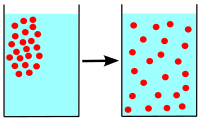
Photo from wikipedia
An accurate quantitative description of the diffusion coefficient in a porous medium is essential for predictive transport modeling. Well-established relations, such as proposed by Buckingham, Penman, and Millington–Quirk, relate the… Click to show full abstract
An accurate quantitative description of the diffusion coefficient in a porous medium is essential for predictive transport modeling. Well-established relations, such as proposed by Buckingham, Penman, and Millington–Quirk, relate the scalar diffusion coefficient to the porous medium’s porosity. To capture the porous medium’s structure in more detail, further models include fitting parameters, geometric, or shape factors. Some models additionally account for the tortuosity, e.g., via Archie’s law. A validation of such models has been carried out mainly via experiments relating the proposed description to a specific class of porous media (by means of parameter fitting). Contrary to these approaches, upscaling methods directly enable calculating the full, potentially anisotropic, effective diffusion tensor without any fitting parameters. As input only the geometric information in terms of a representative elementary volume is needed. To compute the diffusion–porosity relations, supplementary cell problems must be solved numerically and their (flux) solutions must be integrated. We apply this approach to provide easy-to-use quantitative diffusion–porosity relations that are based on representative single grain, platy, blocky, prismatic soil structures, porous networks, or random porous media. As a discretization method, we use the discontinuous Galerkin method on structured grids. To make the relations explicit, interpolation of the obtained data is used. We furthermore compare the obtained diffusion–porosity relations with the well-established relations mentioned above and also with the well-known Voigt–Reiss or Hashin–Shtrikman bounds. We discuss the ranges of validity and further provide the explicit relations between the diffusion and surface area and comment on the role of a tortuosity–porosity relation.
Journal Title: Transport in Porous Media
Year Published: 2018
Link to full text (if available)
Share on Social Media: Sign Up to like & get
recommendations!